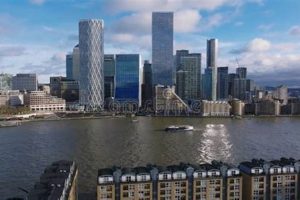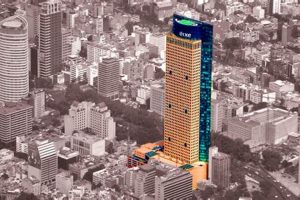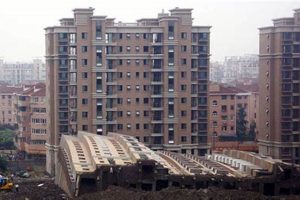Dallas, Texas, is a city renowned for its impressive skyline, adorned with an array of skyscrapers that have shaped its architectural landscape. These towering structures serve as a testament to the city’s economic vitality and ever-evolving urban identity.
The significance of Dallas’ skyscrapers extends beyond their aesthetic appeal. They are hubs of commerce, housing major corporations, financial institutions, and law firms. The presence of these high-rises has fostered a thriving business environment, attracting professionals from various industries and contributing to the city’s economic growth.
Moreover, Dallas’ skyscrapers hold historical significance. The construction of these architectural marvels has coincided with the city’s rise to prominence as a major metropolitan center. The designs of these buildings reflect the evolving architectural styles and technological advancements over the decades. Each skyscraper tells a unique story, showcasing the city’s architectural heritage and its journey towards becoming a global metropolis.
1. Height
The height of Dallas’ skyscrapers is a defining characteristic of the city’s skyline and a major contributor to its identity. The Bank of America Plaza, standing at 72 stories and 921 feet tall, is the tallest building in Dallas and the 15th tallest building in the United States. The Reunion Tower, while shorter at 561 feet, is equally iconic, with its distinctive geodesic sphere observation deck offering panoramic views of the city.
The height of Dallas’ skyscrapers has several important implications. First, it is a symbol of the city’s economic power and prosperity. Tall buildings require significant investment and resources to construct and maintain, and their presence in Dallas indicates a thriving economy and a strong real estate market. Second, the height of Dallas’ skyscrapers provides practical benefits to the city’s residents and businesses. Tall buildings can accommodate more people and businesses in a smaller footprint, which helps to conserve land and reduce traffic congestion. Additionally, the height of Dallas’ skyscrapers allows for stunning views of the city and the surrounding area, which can be enjoyed from observation decks, restaurants, and offices.
In conclusion, the height of Dallas’ skyscrapers is an important aspect of the city’s identity, economy, and quality of life. The Bank of America Plaza and the Reunion Tower are just two examples of the many tall buildings that contribute to Dallas’ unique skyline and make it one of the most recognizable cities in the United States.
2. Architecture
The architecture of Dallas’ skyscrapers is a reflection of the city’s rich history and diverse culture. The city’s oldest skyscrapers, built in the early 20th century, are primarily Art Deco in style, with their characteristic setbacks, geometric ornamentation, and stylized detailing. Notable examples include the Dallas Power & Light Building and the Adolphus Tower.
In the mid-20th century, Dallas experienced a construction boom, and the city’s skyline began to fill with skyscrapers in a variety of architectural styles, including International Style, Brutalist, and Postmodern. The International Style, characterized by its simplicity, clean lines, and use of glass and steel, is exemplified by buildings such as the First National Bank Tower and the Thanksgiving Tower. The Brutalist style, with its emphasis on raw concrete and geometric forms, is represented by the Dallas City Hall and the Thanks-Giving Square.
In recent years, Dallas has seen the construction of several skyscrapers in the Postmodern style, which incorporates elements of both traditional and modern architecture. Notable examples include the Bank of America Plaza and the Reunion Tower. These buildings are characterized by their eclecticism, playful use of color and form, and often include references to historical architectural styles.
The variety of architectural styles in Dallas’ skyscrapers is a reflection of the city’s dynamic and ever-changing identity. The skyscrapers are not only symbols of the city’s economic power and prosperity, but also works of art that contribute to the city’s unique character and appeal.
3. Business
The presence of numerous skyscrapers in Dallas is not only a testament to the city’s economic vitality but also a reflection of its importance as a major business center. Many of these skyscrapers house major corporations, banks, and law firms, creating a concentrated hub of business activity.
This concentration of businesses in Dallas’ skyscrapers has several important implications. First, it attracts a highly skilled workforce to the city. Major corporations, banks, and law firms require employees with specialized knowledge and expertise, and the presence of these companies in Dallas has made the city a magnet for talented professionals. Second, the concentration of businesses in Dallas’ skyscrapers fosters a spirit of innovation and collaboration. With so many businesses located in close proximity, there are ample opportunities for networking, idea-sharing, and the formation of new partnerships.
The importance of Dallas’ skyscrapers as a component of the city’s business center cannot be overstated. These buildings provide a physical space for businesses to operate and grow, and they also create a vibrant and dynamic urban environment that attracts and retains talent. As Dallas continues to grow and prosper, its skyscrapers will undoubtedly continue to play a vital role in the city’s economy and business community.
4. Tourism
The skyscrapers of Dallas are not just symbols of the city’s economic power and architectural prowess; they are also popular tourist attractions in their own right. Many of these skyscrapers offer observation decks and other attractions that provide visitors with stunning views of the city and the surrounding area.
- Observation decks: Many of Dallas’ skyscrapers offer observation decks that provide visitors with panoramic views of the city. Some of the most popular observation decks include the Reunion Tower GeO-Deck, the Bank of America Plaza Observation Deck, and the Dallas World Aquarium.
- Restaurants and bars: Many of Dallas’ skyscrapers also house restaurants and bars that offer diners and drinkers unique views of the city. Some of the most popular restaurants and bars with views include the Five Sixty by Wolfgang Puck at the Reunion Tower, the Cloud Bar at the Hilton Anatol
e, and the Top of the Tower Restaurant & Bar at the Hyatt Regency Dallas. - Other attractions: In addition to observation decks and restaurants, some of Dallas’ skyscrapers also offer other attractions, such as museums, shops, and even a hotel. For example, the Bank of America Plaza is home to the Dallas Holocaust Museum and the Sixth Floor Museum at Dealey Plaza, while the Reunion Tower houses the Reunion Tower GeO-Deck and the Five Sixty by Wolfgang Puck restaurant.
The popularity of Dallas’ skyscrapers as tourist attractions is due to several factors. First, the city’s central location in the United States makes it a convenient destination for tourists from all over the country. Second, Dallas’ skyscrapers offer a variety of attractions that appeal to a wide range of visitors, from families and couples to business travelers and history buffs. Finally, Dallas’ skyscrapers are relatively affordable to visit, with many observation decks and attractions offering discounts for groups and families.
The tourism industry is an important part of the Dallas economy, and the city’s skyscrapers play a major role in attracting visitors. By offering unique and memorable experiences, Dallas’ skyscrapers help to make the city a popular destination for tourists from all over the world.
5. History
The construction of skyscrapers in Dallas is inextricably linked to the city’s growth and prosperity. The early 20th century saw a boom in the construction of skyscrapers in Dallas, as the city experienced a period of rapid economic growth. This growth was driven by the discovery of oil in the region, which led to an influx of new businesses and residents. The construction of skyscrapers continued throughout the 20th century, as Dallas grew into a major metropolitan center. Today, Dallas is home to some of the tallest buildings in the United States, including the Bank of America Plaza and the Reunion Tower.
- Economic Growth: The construction of skyscrapers in Dallas has been closely tied to the city’s economic growth. The early skyscrapers were built during a period of rapid economic growth, and the continued construction of skyscrapers has reflected the city’s continued prosperity.
- Population Growth: The construction of skyscrapers in Dallas has also been driven by the city’s population growth. As the city’s population has grown, the demand for housing and office space has increased, leading to the construction of more skyscrapers.
- Technological Advancements: The construction of skyscrapers in Dallas has been made possible by technological advancements. The development of new construction techniques and materials has allowed for the construction of taller and more complex buildings.
- Architectural Innovation: The construction of skyscrapers in Dallas has also been influenced by architectural innovation. Dallas is home to a number of architecturally significant skyscrapers, including the Bank of America Plaza and the Reunion Tower. These buildings have helped to shape the city’s skyline and have made Dallas a destination for architecture enthusiasts.
The construction of skyscrapers in Dallas is a testament to the city’s growth and prosperity. The city’s skyscrapers are not only symbols of economic power, but also works of art that contribute to the city’s unique character and identity.
6. Culture
The skyscrapers of Dallas are not only symbols of economic power and architectural prowess, but also important cultural landmarks that have been featured in numerous films, television shows, and other media. This has helped to raise the profile of Dallas on the world stage and contribute to its unique cultural identity.
One of the most iconic examples of Dallas skyscrapers in popular culture is the Reunion Tower, which has appeared in films such as “RoboCop” and “The Big Bang Theory.” The tower’s distinctive geodesic sphere observation deck has made it a popular tourist destination and a recognizable symbol of the city.
Another example is the Bank of America Plaza, which was featured in the television show “Dallas” in the 1980s. The show’s popularity helped to make the building one of the most recognizable skyscrapers in the world and a symbol of the city’s economic power.
The presence of Dallas skyscrapers in popular culture has had a number of positive benefits for the city. It has helped to attract tourists, boost the local economy, and create a sense of civic pride. It has also helped to shape the city’s image as a modern and cosmopolitan metropolis.
In conclusion, the skyscrapers of Dallas are not only architectural marvels, but also important cultural landmarks that have played a significant role in shaping the city’s identity. Their presence in popular culture has helped to raise the profile of Dallas on the world stage and boost the local economy.
7. Sustainability
The incorporation of sustainability into the design of Dallas’ newer skyscrapers is a testament to the city’s commitment to environmental stewardship and a greener future. These buildings are not only architectural marvels, but also beacons of innovation and efficiency.
One notable example is the Bank of America Plaza, which achieved LEED Platinum certification in 2019. The building features a number of sustainable design elements, including a high-performance glass curtain wall that reduces heat gain, a rainwater harvesting system, and a green roof that helps to insulate the building and reduce stormwater runoff.
Another example is the 1700 Pacific Building, which was awarded LEED Gold certification in 2017. The building features a number of sustainable design elements, including a solar panel array, a green roof, and a rainwater harvesting system. These features help to reduce the building’s energy consumption and environmental impact.
The incorporation of sustainability into the design of Dallas’ newer skyscrapers is a positive trend that is expected to continue in the years to come. As the city continues to grow and develop, it is essential that new buildings are designed and constructed in a sustainable manner. This will help to reduce the city’s environmental impact and ensure a more sustainable future for generations to come.
8. Community
The skyscrapers of Dallas, Texas, are more than just tall buildings; they are also important community landmarks that serve as gathering places for residents and visitors alike. This sense of community is fostered by a number of factors, including the buildings’ unique architectural features, their central location, and their association with major events and cultural attractions.
- Architectural Features: Many of Dallas’ skyscrapers are designed with public spaces and amenities that encourage people to gather and interact. For example, the Reunion Tower features a GeO-Deck observation deck that offers panoramic views of the city, while the Bank of America Plaza has a public plaza tha
t hosts events and activities throughout the year. - Central Location: The skyscrapers of Dallas are located in the heart of the city’s downtown business district, which is also home to a number of cultural attractions, restaurants, and shops. This central location makes it easy for people to visit the skyscrapers and participate in the activities they offer.
- Major Events and Cultural Attractions: The skyscrapers of Dallas are often used as venues for major events and cultural attractions. For example, the Reunion Tower is a popular spot for New Year’s Eve celebrations, while the Bank of America Plaza has hosted concerts and art exhibitions. These events help to draw people to the skyscrapers and create a sense of community.
The sense of community fostered by the skyscrapers of Dallas is an important part of the city’s identity. These buildings are not only symbols of economic power and architectural prowess, but also places where people can come together to celebrate, socialize, and enjoy the city’s many cultural offerings.
FAQs about Dallas Texas Skyscrapers
This section provides answers to frequently asked questions about the skyscrapers of Dallas, Texas. These questions address common concerns or misconceptions about these iconic structures, offering concise and informative responses.
Question 1: What is the tallest skyscraper in Dallas?
The tallest skyscraper in Dallas is the Bank of America Plaza, standing at 72 stories and 921 feet tall.
Question 2: What is the most iconic skyscraper in Dallas?
The most iconic skyscraper in Dallas is the Reunion Tower, known for its distinctive geodesic sphere observation deck.
Question 3: Are the skyscrapers in Dallas safe?
Yes, the skyscrapers in Dallas are safe. They are built to meet strict building codes and safety standards, and they are regularly inspected and maintained.
Question 4: Can tourists visit the skyscrapers in Dallas?
Yes, tourists can visit many of the skyscrapers in Dallas. Some skyscrapers offer observation decks, restaurants, and other attractions that are open to the public.
Question 5: What is the future of skyscrapers in Dallas?
The future of skyscrapers in Dallas is bright. The city is continuing to grow and develop, and new skyscrapers are being built all the time. These new skyscrapers are becoming increasingly sustainable and technologically advanced, reflecting the city’s commitment to innovation and progress.
In summary, the skyscrapers of Dallas are impressive architectural landmarks that contribute to the city’s identity and economic vitality. They are safe, accessible to tourists, and offer stunning views of the city. As Dallas continues to grow and develop, its skyscrapers will undoubtedly continue to play a vital role in shaping the city’s skyline and identity.
Transition to the next article section:
The skyscrapers of Dallas are just one example of the city’s commitment to innovation and progress. In the next section, we will explore other aspects of Dallas that make it a vibrant and exciting city to live in and visit.
Tips for Visiting Dallas Texas Skyscrapers
Visiting the skyscrapers of Dallas, Texas, can be a memorable and enriching experience. Here are a few tips to help you make the most of your visit:
Tip 1: Do your research.
Before you visit, take some time to research the different skyscrapers in Dallas. Learn about their history, architecture, and amenities. This will help you decide which skyscrapers you want to visit and how much time you want to spend at each one.
Tip 2: Purchase a CityPASS.
If you plan on visiting multiple skyscrapers, consider purchasing a CityPASS. A CityPASS gives you admission to four of Dallas’ most popular attractions, including the Reunion Tower and the Perot Museum of Nature and Science. It’s a great way to save money and see more of the city.
Tip 3: Visit during off-peak hours.
If you want to avoid crowds, visit the skyscrapers during off-peak hours. Weekdays and early mornings are typically less crowded than weekends and afternoons.
Tip 4: Take your time.
Don’t rush your visit. Take some time to explore each skyscraper and enjoy the views. Many skyscrapers have observation decks that offer panoramic views of the city. Be sure to take your time and soak in the scenery.
Tip 5: Bring your camera.
The skyscrapers of Dallas are beautiful works of architecture. Be sure to bring your camera so you can capture some amazing photos.
Tip 6: Be respectful.
The skyscrapers of Dallas are home to businesses and residents. Be respectful of their space and follow the rules and regulations of each building.
Tip 7: Have fun!
Visiting the skyscrapers of Dallas is a great way to experience the city’s culture and architecture. Be sure to have fun and enjoy your visit.
Summary:
By following these tips, you can make the most of your visit to the skyscrapers of Dallas, Texas. These iconic structures offer stunning views, fascinating history, and a unique glimpse into the city’s culture and architecture.
Conclusion:
Dallas, Texas, is a vibrant and exciting city with a rich skyline. The city’s skyscrapers are a testament to its economic power and architectural prowess. Whether you’re a tourist or a local resident, be sure to visit the skyscrapers of Dallas and experience their beauty and grandeur firsthand.
Conclusion
The skyscrapers of Dallas, Texas, are a testament to the city’s economic power, architectural prowess, and cultural identity. These iconic structures offer stunning views, fascinating history, and a unique glimpse into the city’s past, present, and future.
As Dallas continues to grow and develop, its skyscrapers will undoubtedly continue to play a vital role in shaping the city’s skyline and identity. These buildings are not only symbols of economic power and architectural achievement, but also places where people can come together to celebrate, socialize, and enjoy the city’s many cultural offerings.







